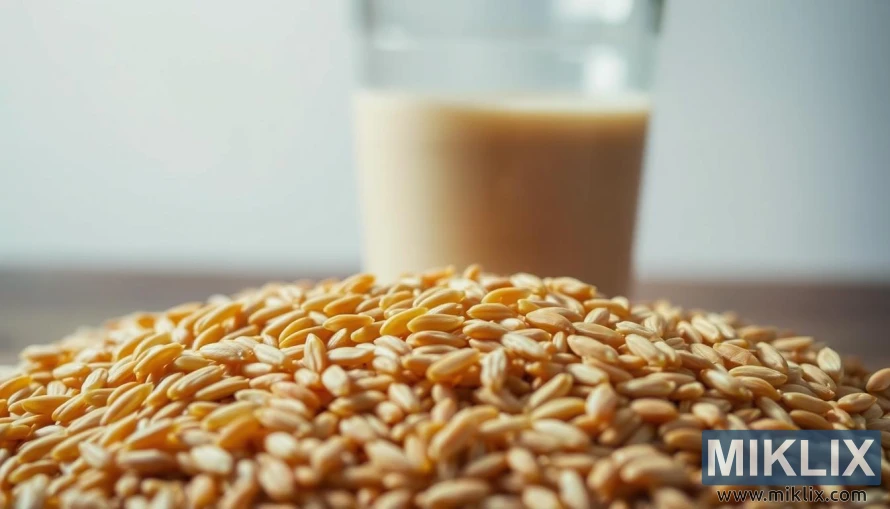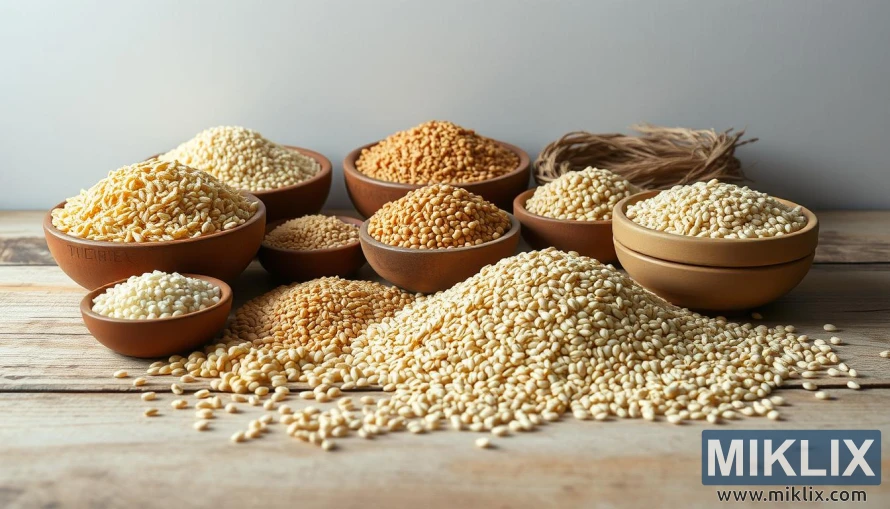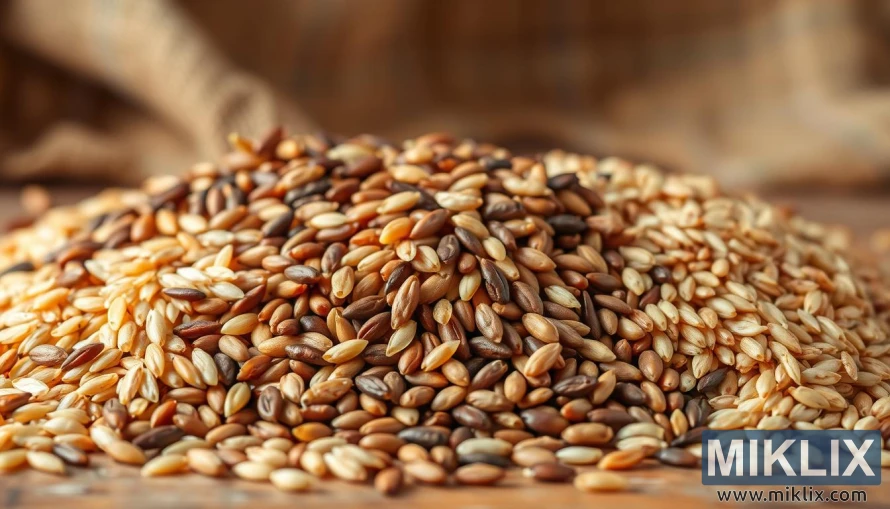Brown Rice, Bold Benefits: Why This Whole Grain Deserves a Spot on Your Plate
Published: May 12, 2025 at 8:31:00 PM UTC
Brown rice is a whole grain packed with essential nutrients. It's a great addition to your diet because it offers many health benefits. Unlike white rice, brown rice keeps its bran and germ, giving you more nutrition and fiber. This article explores how brown rice can help you lose weight, improve heart health, and control blood sugar. It also stresses the importance of whole grains in a balanced diet.

Key Takeaways
- Brown rice is a whole grain that retains its bran and germ, providing superior nutrition.
- Incorporating brown rice into your meals can aid in weight loss efforts.
- This grain supports heart health through its high fiber and nutrient content.
- Brown rice can help improve blood sugar control, making it a smart choice for diabetics.
- Choosing brown rice promotes digestive health due to its dietary fiber.
- This gluten-free option is suitable for various dietary preferences.
- There are many delicious ways to incorporate brown rice into your meals.
Introduction to Brown Rice
Brown rice is an ancient grain that has been a staple for thousands of years. It nourishes over 3.5 billion people worldwide. Unlike white rice, brown rice keeps its bran and germ layers, making it more nutritious.
This nutrient-rich food offers many health benefits. It boosts overall well-being. Adding brown rice to your meals can make your diet more balanced.
It provides essential vitamins, minerals, and fiber. Its wholesome nature aids in better digestion. It may also help prevent chronic diseases. Brown rice is loved for its rich flavor and versatility in cooking.
Why Choose Brown Rice Over White Rice?
Choosing between brown rice and white rice is key for a healthy diet. Brown rice is better because it's packed with nutrients. It keeps vitamins and minerals, unlike white rice, which loses them during processing.
Brown rice is a whole grain. This means it has fiber, antioxidants, and other nutrients. These are lost in white rice.
By picking brown rice, you get more health benefits. It tastes great and helps with digestion and energy. Making this choice can greatly improve your diet.
High Nutritional Content of Brown Rice
Brown rice is packed with vitamins, minerals, and dietary fiber. It keeps more nutrients than white rice, making it great for those who care about their health. One cup of cooked brown rice has about 248 calories, 52 grams of carbs, and 3.2 grams of fiber.
Brown rice is rich in B vitamins, which help make energy. It also has magnesium and selenium, important for our bodies. Eating brown rice helps keep your diet balanced and supports your digestive health.
Health Benefits of Brown Rice
Brown rice is packed with health benefits that boost your overall well-being. It's full of essential nutrients, making it key to a balanced diet. The fiber in brown rice helps your digestive system by keeping bowel movements regular and preventing constipation.
This fiber also helps you feel full for longer. It's perfect for those trying to control their weight. Brown rice is not just about fiber; it's also rich in antioxidants.
These antioxidants fight oxidative stress in your body, which can lead to chronic diseases. Eating brown rice regularly can help reduce inflammation and lower heart disease risk. Adding brown rice to your meals satisfies your hunger and boosts your health.
Brown Rice and Weight Loss
Adding brown rice to your meals can help with weight loss. It has more fiber than white rice, which makes you feel full longer. This helps control hunger and reduces the need to snack between meals.
Research shows that whole grains like brown rice help you eat fewer calories. Switching to brown rice can make your meals more satisfying. This simple change can help you manage your weight while enjoying your food.
Heart Health Benefits of Brown Rice
Brown rice is great for your heart. It's full of fiber, which helps lower cholesterol. Eating foods high in fiber can reduce the risk of heart disease.
Brown rice also has magnesium, a key mineral for the heart. It helps control blood pressure. Research shows that enough magnesium can improve heart health.
Adding brown rice to your meals can help your heart. Try swapping white rice for brown to get more nutrients.

Improved Blood Sugar Control
Brown rice is great for controlling blood sugar, making it perfect for those with diabetes. It has a lower glycemic index than white rice. This means it helps keep blood sugar levels steady.
Research shows that eating brown rice instead of white rice can improve blood sugar after meals. This change helps manage blood sugar better and lowers the risk of type 2 diabetes. Brown rice is digested slowly, releasing glucose into the blood gradually. This is good for keeping blood sugar stable.
Adding brown rice to meals can improve your diet and help manage blood sugar. Choosing brown rice lets you enjoy its health benefits while reaching your health goals.
Brown Rice and Digestive Health
Brown rice is great for your digestive health because it's full of dietary fiber. This fiber helps your body move waste out smoothly. It also keeps your gut microbiome healthy, which is key for a good gut.
Eating brown rice can help avoid constipation and make digestion better. Its nutty taste and chewy texture make it a tasty addition to many meals. Choosing brown rice over white rice can really help your gut health.
Natural Gluten-Free Option
Brown rice is a naturally gluten-free grain. It's great for those with gluten intolerance or celiac disease. Many people choose gluten-free diets, and finding good options can be hard. Brown rice is both nutritious and meets dietary needs.
Unlike many gluten-free products, brown rice is full of vitamins, minerals, and fiber. It's a healthy choice for those avoiding gluten. It helps keep you well while fitting into a gluten-free diet.
For those with celiac disease or gluten sensitivity, brown rice is easy to add to meals. It works well in stir-fries and salads. This grain makes your diet better and supports gluten-free living.

Incorporating Brown Rice into Your Diet
Brown rice is a versatile grain that can fit into various meals throughout your day. It's flexible in the kitchen and can be a base for many dishes. This hearty grain boosts nutritional value and keeps meals satisfying.
For breakfast, try a warm bowl of brown rice with fruits and nuts. Add yogurt for a delicious, healthy start to your day. Lunch can be a brown rice salad with fresh veggies and your favorite protein, making simple ingredients into tasty meals.
Dinner is a time for creativity with brown rice. It's great in stir-fries with colorful veggies and your favorite sauces. Or, use it in comforting soups for a filling meal. Brown rice adds texture and flavor to your meals, making them exciting.
Adding brown rice to your diet can be fun and rewarding. It makes your meals more interesting and nutritious. Experiment with different recipes to find your favorites.
Environmental Impact and Sustainability of Brown Rice
Brown rice farming is good for the planet and offers many benefits. It's a whole grain that needs less processing than white rice. This makes it better for the environment.
It also keeps more nutrients in the rice. This means less energy is used during production.
Brown rice farming focuses on biodiversity and soil health. Using crop rotation and organic farming reduces chemical use. This helps create healthier ecosystems.
These methods also improve soil fertility. This is key for long-term agricultural success.
Choosing brown rice helps local farmers and communities. Sustainable farming methods make agriculture more resilient. They also help fight climate change.
Farmers who use these methods get better yields and more market access. This is a win-win for everyone.
Brown Rice Varieties and Their Differences
Brown rice comes in many varieties, each with its own taste and texture. You can find long grain and short grain brown rice, perfect for different dishes. Knowing the differences helps with meal planning.
Long grain brown rice is long and fluffy after cooking. It's great for stir-fries and pilafs. Short grain brown rice is stickier, perfect for sushi and creamy risottos. Your choice depends on the recipe and what you like.

There are also basmati and jasmine brown rice varieties. Basmati has a strong aroma, perfect for Indian and Middle Eastern dishes. Jasmine has a sweet taste, great for Thai food. Trying these varieties can make your meals more interesting, with each one having its own health benefits.
Common Misconceptions about Brown Rice
Many people believe brown rice myths that are not true. They think brown rice tastes bad compared to white rice. But, brown rice has a nutty flavor and a chewy texture that many enjoy.
Some think brown rice is hard to cook because it's denser. But, the effort is worth it for its health benefits. It's full of fiber, vitamins, and minerals that are good for you.
Some also think brown rice isn't good for a healthy diet. But, it can help with weight, blood sugar, and heart health. Adding brown rice to your meals can make your diet more balanced and healthy.
Delicious Brown Rice Recipes to Try
Brown rice is a versatile ingredient for many tasty dishes. These recipes will make your cooking healthier and more exciting. You can enjoy everything from hearty grain bowls to simple stir-fries.
Here are some easy and tasty suggestions:
- Stir-Fried Brown Rice: Make a quick stir-fry with broccoli, bell peppers, and carrots. Add soy sauce and sesame oil for extra flavor.
- Brown Rice Grain Bowl: Layer brown rice with roasted veggies, avocado, and a poached egg. Top with your favorite dressing for a nutritious meal.
- Vegetarian Brown Rice Burgers: Mix cooked brown rice with black beans, breadcrumbs, and spices. Grill or pan-fry for a tasty veggie burger.
- Brown Rice and Bean Salad: Combine brown rice with black beans, corn, diced tomatoes, and cilantro. Dress with lime juice and olive oil for a refreshing salad.
- Spanish Brown Rice: Sauté onions and garlic, then add diced tomatoes and spices. Mix in brown rice for a colorful dish that's great as a side or main.
Adding these brown rice recipes to your meals can make them healthier and more enjoyable. Try different ingredients to find your favorite dishes!
Conclusion
Brown rice is packed with health benefits, making it a great choice for a balanced diet. It helps with weight management, heart health, and blood sugar control. Choosing brown rice over other options can boost your overall wellness.
Adding brown rice to your meals can make your diet more diverse and support long-term health. It's a tasty and flexible ingredient that can turn any meal into a healthy treat. This helps you live a healthier life.
Switching to brown rice is a small but significant step towards better eating habits. It offers many health benefits. By choosing brown rice, you're caring for your body and investing in your health for the future.
Further Reading
If you enjoyed this post, you may also like these suggestions:
- Spice Up Your Life: How Chili Boosts Your Body and Brain
- Low-Carb Hero: The Surprising Benefits of Cauliflower
- From Collagen Booster to Brain Calmer: The Full-Body Benefits of Glycine Supplements
